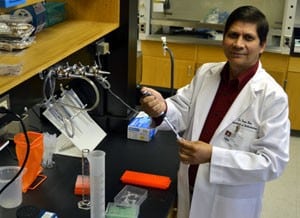Research Gives Insight into Macular Degeneration
May 12, 2011 | A team of University of Arkansas for Medical Sciences (UAMS) researchers studying Age-Related Macular Degeneration (AMD) in the Harvey & Bernice Jones Eye Institute has identified new vessel growth by a compound that ultimately could lead to a better understanding of how AMD is formed and more effective wound care. The team found that when injected into the eye, the compound polyethylene glycol (PEG) produces new blood vessels by activating the complement system, which is a devastating trait of several diseases, including cancer and AMD. This and other key findings are published in the May issue of the prestigious Journal of Biological Chemistry. The full paper can be found here. “We know that the creation of blood vessels is the basis of AMD and several other diseases, so by finding that PEG triggers this reaction leads us toward more important questions,” said Puran Bora, Ph.D., professor of ophthalmology at the UAMS Jones Eye Institute. Those questions include a safety precaution angle, Bora said. The compound PEG is the main ingredient of certain laxatives and cosmetics that are commonly used. “It may prove to be very important to learn what kind of effect, if any, this has on people who use those products in high levels or on a frequent basis,” Bora said. “We don’t know for sure about the role of PEG in those individual products, but we do now know the role of PEG is to produce new blood vessels in the eye.” The flipside of the discovery is that the creation of new blood vessels is a key event in the healing of wounds. Bora said the research team’s next step is to explore the possibilities of using a PEG-infused wound cream or injection that could speed the healing process, possibly to be marketed. When the discovery was made that new vessels were developing, the research team was studying AMD using PEG as a vehicle to inject another compound into the eye. AMD is the leading cause of vision loss and legal blindness in adults older than 60 in the world. The disease destroys the central vision necessary for patients to be able to focus clearly or coherently on objects. The membrane that supports the retina usually keeps new damaging vessels from forming, but the central characteristic of AMD is when those new vessels break through the “Bruch’s” membrane, causing them to multiply and grow. Bora said another important breakthrough of the study is that in past AMD research, scientists have used invasive laser models to attack the membrane. This is the first time injecting the eye with a compound has been successfully used to create an AMD model. “This new model is not only more inexpensive and faster compared to other models, but you don’t need extremely invasive lasers,” Bora said. “We found that when PEG is simply injected into the eye, it dissolves the membrane and new blood vessels are formed, which grow into new networks of vessels that in the long run cause the damage in AMD.” |
